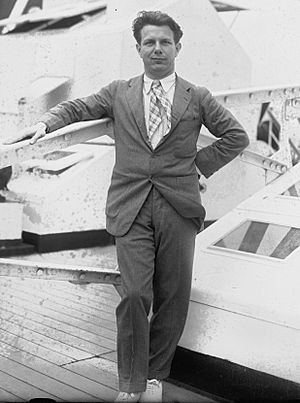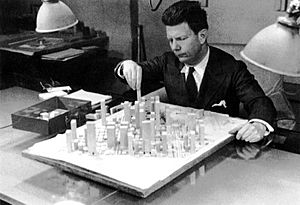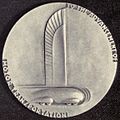Norman Bel Geddes facts for kids
Quick facts for kids
Norman Bel Geddes
|
|
|---|---|
 |
|
| Born |
Norman Melancton Geddes
April 27, 1893 Adrian, Michigan, U.S.
|
| Died | May 8, 1958 (aged 65) New York, New York, U.S.
|
| Nationality | American |
| Occupation | Theatrical designer Industrial designer |
|
Notable work
|
Airliner Number 4 Futurama Mark I computer case |
| Spouse(s) | Helen Belle Schneider Edith Lutyens |
| Children | Barbara Bel Geddes Joan Bel Geddes Ulanov |
Norman Bel Geddes (born Norman Melancton Geddes) was a super creative American designer. He was born on April 27, 1893, and passed away on May 8, 1958. He designed everything from theater stages to futuristic cars and even computer cases! He was known for his big ideas about how the future could look.
Contents
Early Life and Family
Norman Melancton Geddes was born in Adrian, Michigan. He grew up in New Philadelphia, Ohio. His parents were Flora Luelle Yingling and Clifton Terry Geddes.
In 1916, Norman married Helen Belle Schneider. They decided to combine their last names to Bel Geddes. This is how Norman Bel Geddes got his famous name. They had two daughters. One was the actress Barbara Bel Geddes. The other was a writer named Joan Ulanov.
Norman Bel Geddes' Amazing Career
Norman Bel Geddes was a very busy and talented person. He worked as both a theatrical designer and an industrial designer. This means he designed things for plays and movies, and also for everyday products.
Designing for the Stage and Screen
Bel Geddes started his career designing sets for plays. He worked for the Los Angeles Little Theater in 1916. Later, in 1918, he became a scene designer for the famous Metropolitan Opera in New York.
He designed and directed many different shows. These included Broadway plays like Arabesque and The Five O'Clock Girl. He even designed an ice show called It Happened on Ice. He also created sets for a movie called Feet of Clay in 1924. He designed costumes for other famous artists too.
Designing for the Future
In 1927, Bel Geddes opened his own design studio. He designed many different products for companies. These included things like cocktail shakers and radio cabinets. But he was most famous for his futuristic ideas.
He imagined a car shaped like a teardrop. He also designed an amazing "House of Tomorrow." In 1929, he drew plans for "Airliner Number 4." This was a huge, nine-deck airplane that could land on water. It had areas for games, an orchestra, a gym, and even two airplane hangars!
His book Horizons (published in 1932) was very important. It helped make the "streamlining" design style popular. This style made things look smooth and modern. He also wrote articles about the future for popular magazines.
Bel Geddes helped design the look of the future world in the science fiction film Things to Come (1936).
The Futurama Exhibit
One of his most famous projects was the Futurama exhibit. He designed this for the 1939 New York World's Fair. It was a huge display for General Motors.
Futurama showed people what cities and highways might look like in the future. It was a very popular and influential exhibit. Bel Geddes had already worked on a similar idea in 1936. That project was called "Metropolis City of 1960."
Designing the Mark I Computer Case
Norman Bel Geddes even designed the case for the Harvard Mark I computer. This computer was very important during World War II. IBM's Thomas Watson gave it to Harvard University. Some people thought designing a fancy case was a waste of money back then. But it showed how design could be important for new technology.
Later Life and Legacy
Norman Bel Geddes passed away in New York on May 8, 1958. His autobiography, Miracle in the Evening, was published after he died.
Bel Geddes is a member of the American Theater Hall of Fame. His daughter, Barbara Bel Geddes, is also in this Hall of Fame. The United States Postal Service even made a postage stamp to honor him. The stamp recognized him as a "Pioneer Of American Industrial Design."
Many of his designs and papers are kept safe at the Harry Ransom Center in Texas. This collection includes his models, drawings, and notes.
Gallery
-
A full-size street intersection in the City of the Future at the Futurama exhibit.
Selected Publications
- Horizons (1932)
- Magic Motorways (1940)
- Miracle in the Evening: An Autobiography (1960)
See also
 In Spanish: Norman Bel Geddes para niños
In Spanish: Norman Bel Geddes para niños









